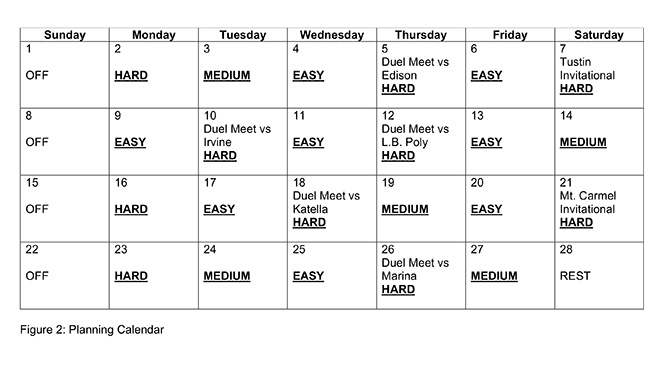How To Setup A Track & Field Training Schedule
With the ever-growing information available on methods for training, strength and conditioning, and speed/power development, it is essential that coaches and athletes can organize these methods into a coherent and effective training plan. For many who first attempt organized training, there is a tendency to try to do too much at once. To “make sure they are not missing something that will give them an advantage” or “not get in a situation where their potential opponent is outworking them.”
These common fears often lead to overtraining, which in turn can lead to decreased performance and injury. The purpose of this article is to try to provide a simple way to set up a Track & Field training schedule. The general theory behind these organizational principles can be used for other seasons and other sports.
All gains are made during recovery.
There is a saying that all gains are made during recovery. What is vital for a high school or club coach or athlete to understand is that much of their success in properly planning their training relies on implementing the proper rest and recovery periods. Track and Field is a performance sport, and all you need is a good attempt or well-executed race to win, so being able to make sure you are fresh and rested at the right time is paramount.
This is usually difficult at the high school/middle school level because the coach faces getting their athletes in shape while also in the competitive season. There is no “winning the fourth quarter” or “outworking your opponent during the contest.” Too little rest between training sessions will eventually lead to decreased performance due to overtraining. While allowing too much rest between training bouts can still allow for improved performance, but not at the rate of optimally planned performance.
When thinking about setting up training, we can talk about it from a few different perspectives. The first is from a short-term perspective that can be looked at as approaching and organizing a single training day. The next perspective can be to take a step back and decide how to organize a series of training days into a week of balanced training. Finally, an even broader view can be taken to arrange a series of training weeks to comprise a month of organized training. Properly planned training cycles can be put together in 2 to 5-week segments of continuous training, based upon the type of training and the upcoming competition schedule. There is almost always an active rest week inserted between training blocks to allow the body to recover and repair in preparation for the next training block. This active rest week will involve only a combination of technique work mixed with very light physical training. Too many weeks of consecutive training will lead to staleness and increase the possibility for injury. Therefore, rest weeks are critical for optimal performance. For example, in a typical high school/middle school setting, one will probably be able to fit in three to four training blocks during the track & field season between February and June.
Training cycles/blocks will change in intensity (how hard you are training) and volume (the amount of training) as the training year progresses. Generally, the first training cycle has a lot of volume at a lower intensity. Each successive cycle will have lowering volume levels with a matching increase in intensity. This type of adjustment of volume and intensity will allow the athlete to peak at the end of the training year when the most important competitions occur.
How to set up your training cycles (month to month training)
Setting up your series of training cycles (follow along in Figure 1, which is a hypothetical example) starts by writing out a list of all the meets you or your athletes will compete in. Next, identify which meets you would like you or your athletes to peak for. After identifying your “peaking” competitions, make sure you or your athletes are given an active rest week leading up to those competitions. The weeks between the meets that you or your athletes will peak for represent each training block/cycle. Figure 1 provides an example of how to fit three training cycles into a hypothetical high school season in California. Table 1 provides an overview of how these different training cycles are classified.
Figure 1: Full Season Meet Schedule Setting Up Training Cycles
Date Meet Peak Training
- June 1: State Meet yes Peaking
- May 25: Regional yes Peaking
- May 17: Regional Prelims no Competition Cycle week 2
- May 10: District no Competition Cycle week 1
- May 3: Conference yes Active rest
- April 26: Duel vs Marina no Competition Cycle week 3
- April 19: Duel vs El Cajon no Competition Cycle week 2
- April 12: Tustin Invit. no Competition Cycle week 1
- April 5: Mt. Carmel Invit. yes Active rest
- March 29: Duel vs Colton no Pre-Comp. Cycle week 5
- March 22: Cerritos Relays no Pre-Comp. Cycle week 4
- March 15: Duel vs Hart no Pre-Comp. Cycle week 3
- March 8: Duel vs El Rancho no Pre-Comp. Cycle week 2
- March 1: L Duel vs Troy no Pre-Comp. Cycle week 1
- Feb 22: Practice meet no Preseason conditioning
Remember that when determining “peaking” meets, not all athletes may want or need to peak for the same meet. Simultaneously, there may also be some meets that the whole team will want to peak for (such as a critical invitational or conference championship). Therefore, some athletes will have different training schedules from others. Remember that you will only want to use one active rest week between cycles. Only allow them to peak for one or two closely scheduled meets at one time. The exception to this rule would be at the end of the season after the last training cycle. Athletes can generally hold their peak for about 14-17 days, so it makes sense to back off hard training at least a week to 10 days before the biggest competitions of the year.
How To Set Up Your Training Within A Cycle (Week To Week Training)
Within a given training cycle, you will want to adjust the intensity of training every day to allow for recovery and avoid overtraining and injuries. This can be tricky during the competitive season. With the aid of Figure 2, a quick and easy way to set up a weekly training schedule that I “borrowed” from Manny Bautista of San Diego Mesa College will be demonstrated. Start off by taking a monthly planner and write in all the competition dates. Designate that all competitions are hard training days because the athletes will go 100% in these meets. Next, designate all the days that come before a hard day to be an easy day. Never have two hard days in a row if you can help it. The next step will be to make Sundays a rest (complete rest) day unless there is a competition. Using these three rules, the monthly planner (in Figure 2) will have 16 of the 28 days already designated without having to think about it. With the remaining 12 days, try to plug in a combination of hard and medium days without having back-to-back hard workout days. The result will look like what is presented in Figure 2.
Individual Considerations For Planned Training
When deciding what type of training volumes and intensities to use coach must consider the type of conditioning that the athlete has already undergone before the beginning of track and field training. Many track and field athletes enter the track and field season after completing another competitive season in some other sport. The coach or athlete must analyze this previous activity and count it as a preseason conditioning phase for Track and Field. The jump training from volleyball or basketball or soccer running can often serve as excellent cross-training for the track and field athlete. The training effects derived from other sports will often influence the length and /or intensity of the Preseason or Pre-Competition Phase.
Planning a full-season training schedule can sometimes seem like a long and complicated task. The athletes must be allowed proper times to recover between workouts and between training cycles. Failure to allow for proper recovery will lead to plateauing, staleness, and possibly injury. As the athlete becomes more advanced, choosing the proper training and recovery periods becomes increasingly more important for success.
Athletes should be exposed to the proper way to organize their training at a young age. This helps athletes understand when to work and when to rest, instead of learning by trial and error. This allows the athlete to get the most work out of their hard work and effort.
Read More
RECOMMENDED FOR YOU
MOST POPULAR
How To Setup A Track & Field Training Schedule
With the ever-growing information available on methods for training, strength and conditioning, and speed/power development, it is essential that coaches and athletes can organize these methods into a coherent and effective training plan. For many who first attempt organized training, there is a tendency to try to do too much at once. To “make sure they are not missing something that will give them an advantage” or “not get in a situation where their potential opponent is outworking them.”
These common fears often lead to overtraining, which in turn can lead to decreased performance and injury. The purpose of this article is to try to provide a simple way to set up a Track & Field training schedule. The general theory behind these organizational principles can be used for other seasons and other sports.
All gains are made during recovery.
There is a saying that all gains are made during recovery. What is vital for a high school or club coach or athlete to understand is that much of their success in properly planning their training relies on implementing the proper rest and recovery periods. Track and Field is a performance sport, and all you need is a good attempt or well-executed race to win, so being able to make sure you are fresh and rested at the right time is paramount.
This is usually difficult at the high school/middle school level because the coach faces getting their athletes in shape while also in the competitive season. There is no “winning the fourth quarter” or “outworking your opponent during the contest.” Too little rest between training sessions will eventually lead to decreased performance due to overtraining. While allowing too much rest between training bouts can still allow for improved performance, but not at the rate of optimally planned performance.
When thinking about setting up training, we can talk about it from a few different perspectives. The first is from a short-term perspective that can be looked at as approaching and organizing a single training day. The next perspective can be to take a step back and decide how to organize a series of training days into a week of balanced training. Finally, an even broader view can be taken to arrange a series of training weeks to comprise a month of organized training. Properly planned training cycles can be put together in 2 to 5-week segments of continuous training, based upon the type of training and the upcoming competition schedule. There is almost always an active rest week inserted between training blocks to allow the body to recover and repair in preparation for the next training block. This active rest week will involve only a combination of technique work mixed with very light physical training. Too many weeks of consecutive training will lead to staleness and increase the possibility for injury. Therefore, rest weeks are critical for optimal performance. For example, in a typical high school/middle school setting, one will probably be able to fit in three to four training blocks during the track & field season between February and June.
Training cycles/blocks will change in intensity (how hard you are training) and volume (the amount of training) as the training year progresses. Generally, the first training cycle has a lot of volume at a lower intensity. Each successive cycle will have lowering volume levels with a matching increase in intensity. This type of adjustment of volume and intensity will allow the athlete to peak at the end of the training year when the most important competitions occur.
How to set up your training cycles (month to month training)
Setting up your series of training cycles (follow along in Figure 1, which is a hypothetical example) starts by writing out a list of all the meets you or your athletes will compete in. Next, identify which meets you would like you or your athletes to peak for. After identifying your “peaking” competitions, make sure you or your athletes are given an active rest week leading up to those competitions. The weeks between the meets that you or your athletes will peak for represent each training block/cycle. Figure 1 provides an example of how to fit three training cycles into a hypothetical high school season in California. Table 1 provides an overview of how these different training cycles are classified.
Figure 1: Full Season Meet Schedule Setting Up Training Cycles
Date Meet Peak Training
- June 1: State Meet yes Peaking
- May 25: Regional yes Peaking
- May 17: Regional Prelims no Competition Cycle week 2
- May 10: District no Competition Cycle week 1
- May 3: Conference yes Active rest
- April 26: Duel vs Marina no Competition Cycle week 3
- April 19: Duel vs El Cajon no Competition Cycle week 2
- April 12: Tustin Invit. no Competition Cycle week 1
- April 5: Mt. Carmel Invit. yes Active rest
- March 29: Duel vs Colton no Pre-Comp. Cycle week 5
- March 22: Cerritos Relays no Pre-Comp. Cycle week 4
- March 15: Duel vs Hart no Pre-Comp. Cycle week 3
- March 8: Duel vs El Rancho no Pre-Comp. Cycle week 2
- March 1: L Duel vs Troy no Pre-Comp. Cycle week 1
- Feb 22: Practice meet no Preseason conditioning
Remember that when determining “peaking” meets, not all athletes may want or need to peak for the same meet. Simultaneously, there may also be some meets that the whole team will want to peak for (such as a critical invitational or conference championship). Therefore, some athletes will have different training schedules from others. Remember that you will only want to use one active rest week between cycles. Only allow them to peak for one or two closely scheduled meets at one time. The exception to this rule would be at the end of the season after the last training cycle. Athletes can generally hold their peak for about 14-17 days, so it makes sense to back off hard training at least a week to 10 days before the biggest competitions of the year.
How To Set Up Your Training Within A Cycle (Week To Week Training)
Within a given training cycle, you will want to adjust the intensity of training every day to allow for recovery and avoid overtraining and injuries. This can be tricky during the competitive season. With the aid of Figure 2, a quick and easy way to set up a weekly training schedule that I “borrowed” from Manny Bautista of San Diego Mesa College will be demonstrated. Start off by taking a monthly planner and write in all the competition dates. Designate that all competitions are hard training days because the athletes will go 100% in these meets. Next, designate all the days that come before a hard day to be an easy day. Never have two hard days in a row if you can help it. The next step will be to make Sundays a rest (complete rest) day unless there is a competition. Using these three rules, the monthly planner (in Figure 2) will have 16 of the 28 days already designated without having to think about it. With the remaining 12 days, try to plug in a combination of hard and medium days without having back-to-back hard workout days. The result will look like what is presented in Figure 2.
Individual Considerations For Planned Training
When deciding what type of training volumes and intensities to use coach must consider the type of conditioning that the athlete has already undergone before the beginning of track and field training. Many track and field athletes enter the track and field season after completing another competitive season in some other sport. The coach or athlete must analyze this previous activity and count it as a preseason conditioning phase for Track and Field. The jump training from volleyball or basketball or soccer running can often serve as excellent cross-training for the track and field athlete. The training effects derived from other sports will often influence the length and /or intensity of the Preseason or Pre-Competition Phase.
Planning a full-season training schedule can sometimes seem like a long and complicated task. The athletes must be allowed proper times to recover between workouts and between training cycles. Failure to allow for proper recovery will lead to plateauing, staleness, and possibly injury. As the athlete becomes more advanced, choosing the proper training and recovery periods becomes increasingly more important for success.
Athletes should be exposed to the proper way to organize their training at a young age. This helps athletes understand when to work and when to rest, instead of learning by trial and error. This allows the athlete to get the most work out of their hard work and effort.
Read More













